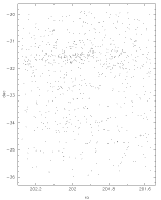
v. Repeatibility Tests
The photometric repeatability of galaxies seen toward the Abell 3558 galaxy cluster (z=0.048; glat = 31°) demonstrate that 2MASS satisfactorily achieves the Level-1 photometric science requirements. The most accurate measurements are made with the 7´´ radius circular apertures, which are the optimum magnitudes for color information for the fainter (i.e., smaller) galaxies. The most versatile measurements are the isophotal magnitudes, whose repeatibility RMS also satisfies the science requirements. The isophotal magnitudes, however, underrepresent the "total" flux of a source by ~10-20%. The Kron magnitudes, by design, are a better measure of the total flux (but still systematically underrepresent the "total" flux by ~8%), although the RMS scatter is considerably larger than the isophotal magnitudes. We recommend that the elliptical isophotal magnitudes be used as the "default" for most purposes, while the "total" magnitudes be used as the measure of the total flux coming from the source.
The highlights of the tests are
Derived from a large repeated-scan dataset, the photometric repeatability of the primary 2MASS apertures is presented. The apertures include the circular 7´´ radius, 20 mag arcsec-2 isophotal, Kron and total (extrapolated) versions. See IV.5e.
A number of repeat scans of Abell 3558 were acquired during the month of 2000 April to complement the set taken in 1998 March. The scans compiled are:
The total area is depicted in Figure 1. The scan-scan overlaps of the Abell 3558 core were repeated over 30 times, while the outskirts and most of the cluster area were covered over 15 times; hence, there are more than enough repeats to provide excellent statistics.
 |
| Figure 1 |
In Figure 2 we show the detection repeatability, where white points are uncontaminated sources, green points are contaminated sources, and red points are false extended sources (usually double stars). The key points are that the internal completeness and reliability satisfy the Level-1 Science requirements.
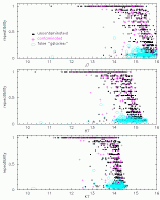 |
| Figure 2 |
In Figure 3 we show the photometric repeatability for the circular R=7´´ aperture. The key point is that the SNR=10 thresholds are J=15.1, H=14.1, and Ks=13.5 mag. However, note the slight overestimation of the estimated uncertainty for Ks-band, where the stellar confusion noise is the sole culprit.
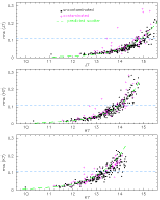 |
| Figure 3 |
Here we assume galaxies to be symmetric and elliptically-shaped
(again, these are reasonable assumptions for most resolved objects).
We also assume that the shape of a galaxy is preserved
from low to high radii--a crude approximation that
is needed for robustness and processing speed. The projected
shape of a galaxy is determined at the 3- isophote. The basic algorithm is detailed in Jarrett et al. 2000. An
improved method for crowded fields
has been deployed for the final 2MASS data processing; described in
IV.5d.
The resulting axis ratio and position angle represent
the galaxy shape.
Figure 4 shows the axis ratio repeatability for
a 3-
isophote. The basic algorithm is detailed in Jarrett et al. 2000. An
improved method for crowded fields
has been deployed for the final 2MASS data processing; described in
IV.5d.
The resulting axis ratio and position angle represent
the galaxy shape.
Figure 4 shows the axis ratio repeatability for
a 3- isophotal aperture, with a minimum radius of
7´´. In the figure the
meanJ(b/a) == mean J-band axis ratio for (0 < /ba/ < 0.75);
sig = RMS in meanJ or meanK or meanS;
rmsJ(b/a) == statistical RMS in the b/a repeatability;
meanK(b/a) == mean K-band axis ratio for (0 < /ba/ < 0.75);
rmsK(b/a) == statistical RMS in the b/a repeatability;
meanS(b/a) == mean axis ratio for the "super" (J+H+Ks) Atlas
Image; and,
rmsS(b/a) == statistical RMS in the b/a repeatability of the "super"
(J+H+Ks) Atlas Image.
isophotal aperture, with a minimum radius of
7´´. In the figure the
meanJ(b/a) == mean J-band axis ratio for (0 < /ba/ < 0.75);
sig = RMS in meanJ or meanK or meanS;
rmsJ(b/a) == statistical RMS in the b/a repeatability;
meanK(b/a) == mean K-band axis ratio for (0 < /ba/ < 0.75);
rmsK(b/a) == statistical RMS in the b/a repeatability;
meanS(b/a) == mean axis ratio for the "super" (J+H+Ks) Atlas
Image; and,
rmsS(b/a) == statistical RMS in the b/a repeatability of the "super"
(J+H+Ks) Atlas Image.
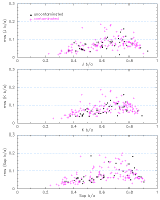 |
| Figure 4 |
Figure 5 shows the 20 mag arcsec-2 isophotal radius repeatability. Figure 6 shows this with a "zoomed-in" scale.
Figure 4 shows the
axis ratio for a 3- isophotal aperture, with
minimum radius of 7´´. Here,
meanJ(b/a) == mean J-band axis ratio for (0 < /ba/ < 0.75);
sig = RMS in meanJ or meanK or meanS;
rmsJ(b/a) == statistical RMS in the b/a repeatability;
meanK(b/a) == mean K-band axis ratio for (0 < /ba/ < 0.75);
rmsK(b/a) == statistical RMS in the b/a repeatability;
meanS(b/a) == mean axis ratio for the "super" (J+H+Ks) Atlas
Image; and,
rmsS(b/a) == statistical RMS in the b/a repeatability of the "super"
(J+H+Ks) Atlas Image.
isophotal aperture, with
minimum radius of 7´´. Here,
meanJ(b/a) == mean J-band axis ratio for (0 < /ba/ < 0.75);
sig = RMS in meanJ or meanK or meanS;
rmsJ(b/a) == statistical RMS in the b/a repeatability;
meanK(b/a) == mean K-band axis ratio for (0 < /ba/ < 0.75);
rmsK(b/a) == statistical RMS in the b/a repeatability;
meanS(b/a) == mean axis ratio for the "super" (J+H+Ks) Atlas
Image; and,
rmsS(b/a) == statistical RMS in the b/a repeatability of the "super"
(J+H+Ks) Atlas Image.
Figure 7 show the elliptical Ks-band fiducial (20 mag arcsec-2) isophotal photometry. Figure 8 shows the circular Ks-band fiducial (20 mag arcsec-2) isophotal photometry. The key points are that the SNR=10 photometric thresholds are J=14.8, H=14.0, and Ks=13.4 mag, and that the uncertainty in the isophotal radii is typically 5-10%, while the axis ratio RMS is ~5%.
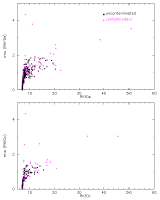 |
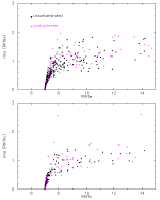 |
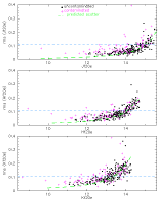 |
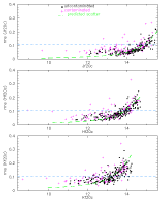 |
| Figure 5 | Figure 6 | Figure 7 | Figure 8 |
Figure 9 shows the Kron radius repeatability with the improved GALWORKS. Figure 10 shows the Kron elliptical fiducial photometry, from the preliminary version of GALWORKS. Figure 11 show the Kron elliptical fiducial photometry, from the improved version of GALWORKS. The key points are that the SNR=10 thresholds are J=14.9, H=13.8, and Ks=13.0 mag, and that the RMS scatter is larger for the new GALWORKS version, the reason being that the Kron apertures are now allowed to grow larger (closer to the total radius, and hence, increasing the scatter).
Figure 12 shows the Kron vs. isophotal elliptical fiducial photometry, from the preliminary version of GALWORKS. Figure 13 show the Kron vs. isophotal elliptical fiducial photometry, from the improved version of GALWORKS. The key points are that The Kron aperture photometry from the older version is systematically 0.05 mag brighter than the isophotal photometry, with an (incorrect) trend in brightness. The Kron aperture photometry from the improved version is systematically 0.05-0.15 mag brighter than the isophotal photometry, with no systematic trends in brightness. That is, the systematic trends are greatly reduced in the improved version of GALWORKS, compared to the version used for the preliminary processing.
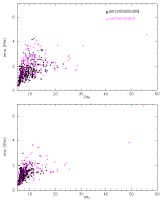 |
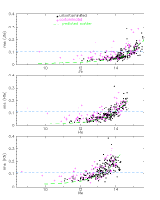 |
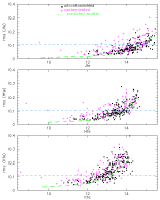 |
| Figure 9 | Figure 10 | Figure 11 |
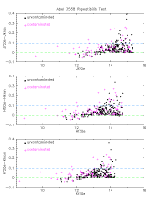 |
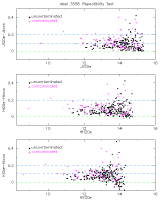 |
| Figure 12 | Figure 13 |
Figure 14 shows the radius of the total aperture in the preliminary version of GALWORKS. Figure 15 shows the total integrated flux in the improved version. The key points are that the SNR=10 thresholds are J=14.5, H=13.0, Ks=12.5 mag, and that the formal (estimated) uncertainties in the photometry (denoted by the purple dashed line) overestimate the true uncertainty at the faint end (J > 14, Ks > 12 mag). Overall the repeatability in the "total" magnitudes looks excellent.
Figure 16 shows the isophotal vs. total integrated flux in the improved GALWORKS. The key points are that the isophotal magnitudes are systematically 0.1-0.3 mag fainter than the total magnitudes, with a more typical value being ~0.2 mag. Hence, we conclude that the isophotal photometry systematically underrepresents the total flux by about 20%. The large scatter is probably due to intrinsic properties of the galaxies (e.g., morphology). Note the trend seen in the J-band magnitudes. Figure 17 shows the Kron vs. total integrated flux in the improved GALWORKS. The key points are that the Kron magnitudes are systematically 0.05-0.2 mag fainter than the total magnitudes, with a more typical value being ~0.08 mag. Hence, we conclude that the Kron photometry systematically underepresents the total flux by about 10%. Again, note the trend seen in J.
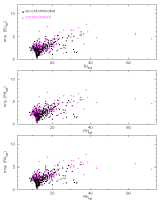 |
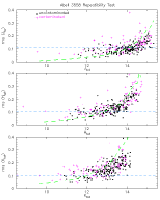 |
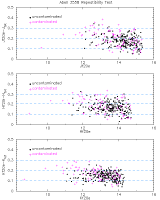 |
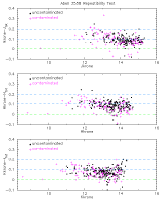 |
| Figure 14 | Figure 15 | Figure 16 | Figure 17 |
We have eliminated in-scan duplicates (which are meaningless for these tests); but, we have included scan-to-scan duplicates (which are meaningful). We treat sources that are "contaminated" separately from sources that are "clean." Contamination means that the photometry flags are tripped (non-zero), indicating that another source is nearby and was masked accordingly (with isophotal substitution to recover the lost flux). We apply the threshold g_score=1.4 as the primary star-galaxy discriminant. For small radii, we adjust the axis ratio, such that the minimum semi-minor axis is 3´´. This modification is needed to counteract the circularizing effects of the PSF. An example of a dynamically adjusted axis ratio is given in IV.5a2. Some examples are given in IV.5a1, including images (before and after star subtraction) and radial profiles.
[Last Updated: 2002 Jul 15; by T. Jarrett]